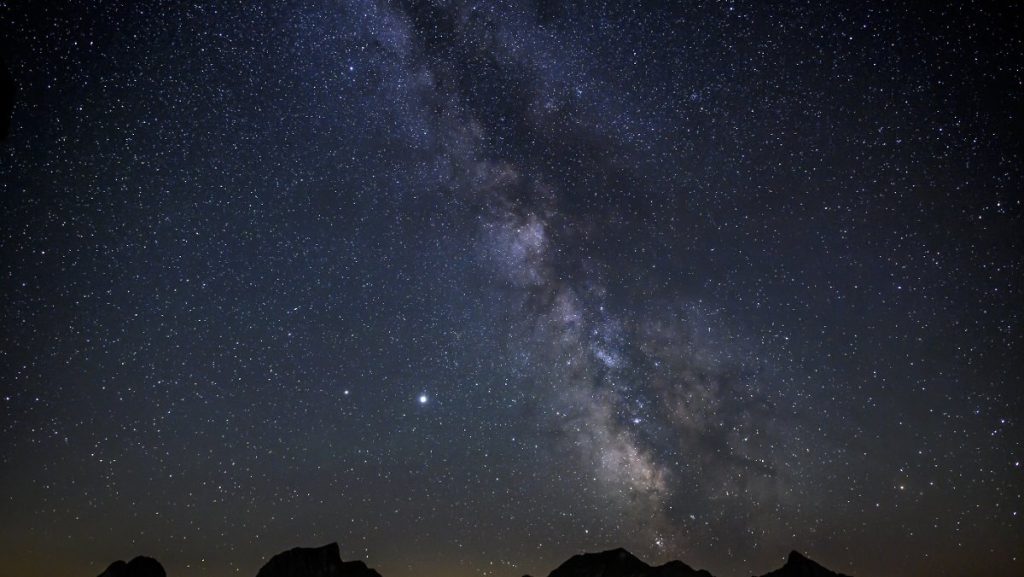sky in july
The triangle of summer and Jupiter lights up at night
30/6/2022 at 6:52 PM
On hot summer nights, people love to watch the stars. The dance of the planets begins in the evening with Saturn. Then comes Jupiter, much superior to it. The month already has a few stars.
Three fixed stars form a constellation prominent in the evening summer sky. One talks about the summer triangle. In July, the summer triangle stands high in the south around midnight. It’s kind of the opposite of the winter hexagon. The Summer Triangle consists of the stars Vega in the harp, Deneb in the swan, and Atair in the eagle. The shape of the swan with its wings spread is represented by a large cross of stars, also known as the Northern Cross.
While Wega with 25 light-years and Atair with 16 light-years are still relatively close to the stars in the solar neighborhood, Deneb with about 2500 light-years is the farthest first-class star. The fact that Deneb is one of the brightest stars in the night sky on Earth is due to its enormous luminosity. This hot, bluish sun is 130,000 times brighter than our sun. If our Sun is as far away as Deneb, it can only be seen with very large telescopes.
In the western celestial sphere there is Arcturus in the constellation Bootes and Spica in the constellation Virgo. They remind you of the days gone by in the spring. Antares can be seen in the far south, and is the main star in the zodiac constellation Scorpio. The heart of the Scorpio represents the heart of the Scorpio sign. Scorpios separate us 550 light years. Its distinctive red color is striking. It is the so-called red giant star. Antares are 15 times the mass of our Sun.
View of the Milky Way
The Milky Way’s summer light band rises in the south between Scorpio and Sagittarius toward Eagle. From here the Milky Way passes through Swan, Cassiopeia and the celestial W, to the northern horizon, where the bright Capella also shines in the chariot. However, the Milky Way can only be seen in really dark areas, and not from our cities and settlements polluted by light. Now there are many people who have never seen the natural phenomenon of the Milky Way in their lives.
After dark, the evening starry sky is still without shiny planets. As the night progresses, Saturn is the first planet to appear in the southeast sky. The planet gradually becomes night. At the end of July, it appears just after 9:30 p.m. over the southeast horizon. At midnight from the night of the fifteenth to the sixteenth, the moon, which is still almost full, can be seen south of Saturn. Five hours later, it’s far away dramatically from the ringed planet.
Jupiter follows Saturn in the dance of the planets at night. The giant planet changes its altitude until just before midnight. At the end of July, Jupiter appears over the eastern horizon shortly after 11 pm. It is by far the brightest planet, shining so brightly that Venus overtakes it after soaring in the morning sky.
Mars is also present in the second half of the night. The reddish planet moves through the constellation Pisces and enters Aries on the eighth. The waning crescent will visit Mars on the night of July 21-22. At 2 a.m., Mars can be seen eight full moon latitudes south of the moon. Mars will get noticeably brighter during July, as Earth catches up with the globe and gets closer and closer to our outer neighbor planet. Venus occupies its position in the morning sky. It rises at the beginning of the month at about 3.30 am, at the end of July after 20 minutes.
The season of falling stars begins
Delta Aquariid Stream meteors can be expected in the morning sky from mid-July through August. In the last third of July, the first Perseids appeared, ensuring the activity of a rapid-fire star in August.
On the thirteenth day, the phase of the full moon is reached. On the same day, shortly after 11 am, the moon will approach the Earth, about 357,260 kilometers away. It has the smallest distance to Earth this year, which is why you can also see the largest full moon. The full moon and at the same time the proximity to the Earth again leads to intense tides with spring tides on the coasts. At a distance of about 406,270 kilometers, the moon will reach its farthest point in its orbit on 26 noon. Two days later, on July 28, the new moon phase occurs.
Already on the fourth of the month, the Earth reaches its farthest point from the sun. On this day, the distance between them is 152 million km from the glowing sphere of the Sun. Sunlight travels from the Sun to Earth in 8 minutes 27 seconds. That’s 17 seconds longer than the time Earth was closest to the sun in early January.
The sun began its descent to the autumnal equinox at the celestial equator. On the twenty-first, she left Gemini early in the morning and moved to the constellation Cancer. A day later, I entered the zodiac sign of Leo an hour before midnight. The length of the day decreases by an hour, and the height of the sun at midday decreases by five degrees.

“Total coffee aficionado. Travel buff. Music ninja. Bacon nerd. Beeraholic.”







More Stories
Researchers detect extremely high-energy gamma rays
Anxiety disorders in old age increase the risk of dementia
Researchers are particularly fascinated by these exoplanets.